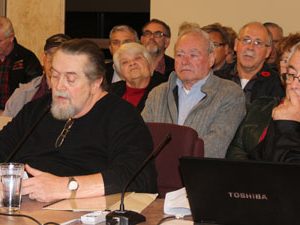by CONNIE TABBERT
Editor
COBDEN — The stagnation of the Township of Whitewater Region may not be too far in the future if Muskrat Lake is not cleaned up.
This seemed to be the message from Dr. James Munro, who was speaking on behalf of the Citizens for the Future of Whitewater Region (CFWR), a group of concerned citizens that formed in early 2005.
“We are painfully aware that rural Ontario and the Ottawa Valley are depopulating, resulting in school closures and a general decline in the quality of rural life,” he told members of the Whitewater Region environmental services committee and a packed council chamber. “It is evident, even now as rural school busing is curtailed. We know when our schools close our churches and businesses can’t be far behind.”
However, it wasn’t all doom and gloom. The CFWR and Cobden Conservation Club have been working diligently the last few years to find a solution to stop the tragic situation with Muskrat Lake.
“Our groups want a prosperous municipality, where we can live, work, raise our children, and have jobs for them so they too can experience the joys of rural living,” Dr. Munro said. “We want to be more than just a playground for the urbanites.”
Muskrat Lake is the jewel of Whitewater Region, he said. It has amazing potential for new residents to enjoy the view and experience a relaxed and rural lifestyle.
“There is the potential for parklands, homes with a view, hiking and walking trails, golf courses, active retirement living, it’s endless,” Dr. Munro said.
However, in order for this to come to fruition, Muskrat Lake must be cleaned up.
Following the release of a report on the water quality of Muskrat Lake in 2005, the CFWR met with the Ministry of Natural Resources (MNR) and Ministry of Environment (MOE) to raise concerns about the deteriorating conditions, he said. At that time, the damaging effects on potential growth and a serious danger to the township’s water supply was in jeopardy.
Both ministries blamed the pollution on residential growth. It was also made clear by the MNR that Muskrat Lake was “their lake” and imposed a 300m (or 1000 foot) setback.
Not wanting to sit back and watch the lake deterioration, they began investigating to see what is really causing the tragic end of Muskrat Lake.
Two government projects appear to have caused the deterioration of Muskrat Lake, Dr. Munro said. The first cause was in 1965 when the federal government, through the Agricultural and Rural Development Act (ARDA), built a dam to block the outflow of the Muskrat River at the output of Muskrat Lake.
This dam raised the water levels, which then caused the wild rice fields in Mud Lake to be destroyed. It also caused the higher water level to force the clay banks to cover up the nice sandy beaches and provide fertile weed beds in Muskrat Lake, he continued.
“In the coming years, this dam would ensure the pollution would remain in the lake to inflict the maximum amount of damage,” Dr. Munro said.
The second major event, which was also through ARDA, was when the Snake River was chosen as the outlet for a major drainage project against the advice of its own environmental consultant Dr. Michael Michalski back in 1981. This involved the destruction of the natural stone dam in Osceola, which allowed the seasonal runoffs to flow into an already dammed lake, he explained.
In his 1981 report, Mr. Michalski stated: approval to proceed with a closed drainage work means the downstream impairment has essentially been authorized by the MOE and the MNR, two provincial agencies who are supposed to be the protectors of Ontario’s water resources.
Thirty years later, in 2011, members of the citizens group met with Mr. Michalski, and after reviewing his report, it’s easy to see his predictions were true, Dr. Munro said.
In 2012, the citizens group and the conservation club persuaded the council (at that time) to obtain the services of Mr. Michalski to aid in the Muskrat Lake planning issues.
Backing up, Dr. Munro noted in 2005, a property owner went to build a home on the lake, only to be advised of the 300 metre setback.
“It’s a good thing that setback was not in effect 100 years ago, because this (township) building we’re in wouldn’t be here,” he said.
Dr. Munro quoted a former township lawyer as saying “As a lawyer, I have witnessed nothing as unjust in the practice of law as the confiscation of value that takes place in the planning process with a simple attachment of an environmental protection that will reduce a landowner’s private property value, often his only asset, by as much as 80 per cent without any compensation whatsoever.”
Mr. Michalski also advised the citizens that the 300m setback had no scientific basis, it was just a number, he said.
This setback was used to point towards the present and future development of the lake as a major source of pollution, Dr. Munro said. By saying that, the government ministries takes attention away from the real cause, which were the two government projects.
The citizens group, alongside the conservation club, continued to work hard behind the scenes to help overcome some of the obstacles to growth in the area, he said.
“Now, in 2015, Muskrat Lake has deteriorated to a point of crisis,” Dr. Munro said. “Instead of a once beautiful lake we once knew and enjoyed, we now have an ugly deterrent to any potential growth within a beautiful lake, and all of this is a by-product of two government sanctioned ARDA projects.
“(Muskrat Lake) must be cleaned up for all to enjoy, both present and any future residents, who may want to locate here to enjoy the views and the rural lifestyle,” Dr. Munro said.
Dr. Munro continued, “We’re tired of declining real estate values, beach closures and destructed shorelines. We’re tired of increased weed growth, algae blooms and contaminated fish stocks. We’re tired of inaction and coverups by government agencies, both federal and provincial, as they play their games.
“It is unimaginable to think that we have a potential toxic threat.
“It’s time for action. The future is now.”
And that future does not include reinventing anything, because a town not too far from Cobden had the same problem of a deteriorating lake, and has recently been able to clean it up.
How? Dr. Munro provided a short movie clip for all to watch, which showed how Lake Heney near Mont St. Marie in Quebec was cleaned up using iron chloride, a naturally based element, that when put into the lake caused a significant improvement in restoring the health and clarity of the lake.
In a brief about Lake Heney, it was noted that in 2004, cottagers purchased a $3.2 million barge with a chemical they hoped would reverse seven years of trout farm pollution that was killing their lake.
In the video, it shows the barge towed by a tugboat which was mixing Lake Heney water with ferric chloride before systematically injecting the resulting red solution into the lake where approximately 1,600 tonnes of this chemical will then cause the phosphates produced by seven years of commercial fish farming to sink to the bottom of the lake, thereby increasing oxygen levels in the water.
After watching the video clip, Dr. Munro said he would not advise where the money would come from to purchase something similar to this to clean up Muskrat Lake.
“More details will become available as we make them public,” he said.
It was agreed the citizens group and council would meet again in the new year to discuss the project in greater detail.
He said those involved with the Lake Heney project have been very helpful in providing information on how to possibly clean up Muskrat Lake. They’ve also agreed to come and talk to council, he added.
Following the meeting, Dr. Munro said, this was an opportunity to properly inform council that there is a solution to clean up Muskrat Lake. The Lake Heney people “have been successful. They have a solution. It worked for them. That’s what we want to do. Muskrat Lake is approximately the same size, the project is very similar, and the problems they faced are very similar to ours.”
This is a multi-tiered government project, but it’s the provincial and federal governments that will fix the problem, since it’s they who created the problem, Dr. Munro said.
With the apparent agreement from council they can come back to a future meeting and discuss the project, Dr. Munro said, “The real work begins now and we move forward. We’ll keep the public informed. We need the public support and I think everybody around here is tired of the fiddling around with what-have-you.
“We’ve got a lake that is a water supply for a municipality and we believe is’s unconscionable to think that as ministries diddle around and play their little games, we have the potential for another Walkerton here.
“We’re not prepared to let that happen. We’re not playing games here. This is serious business right now and we’re very, very concerned.
“We have many people who draw their water from the lake and that’s been the impetus,” Dr. Munro explained.
Prior to Dr. Munro addressing council, Donald E. Broome, who has been a research fanatic regarding Muskrat Lake and how to clear it up in the past years, thanked council for its support.
“Tonight is the culmination of five-and-a-half years of hard work from members of the Whitewater Citizens Group for the Future and the Cobden Conservation Club,” he said.
This club, as well as members of the citizens group, have funded his work beginning in 2011.
“I want to thank each and every member of this township who has supported me publicly,” he said.
He recalled a summer council meeting, where Reeve Terry Millar vindicated the work done by Mr. Broome, and “in a most direct manner, sat in this very room and did what he does best — he called a spade a spade. He told the truth to everyone present and he held nothing back, as did Councillor Chris Olmstead, who said, we’ve been there and we’ve done that. It’s now time for action.”
He also thanked Councillor Daryl McLaughlin and Mayor Hal Johnson for their unwavering support.
Mr. Broome said there is a plan of action to move forward and successfully bring Muskrat Lake back to its previous glory. He then invited Dr. Munro to finish the delegation.






![Kenopic/Smith Auction [Paid Ad]](https://whitewaternews.ca/wp-content/uploads/2018/10/advertising-100x75.jpeg)

